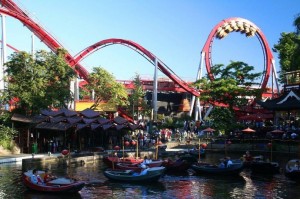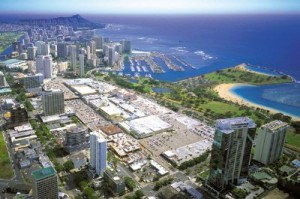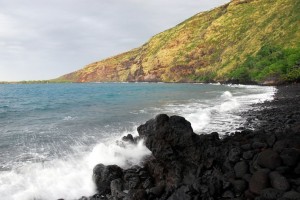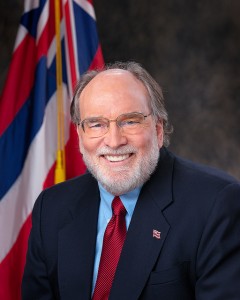Public Land Development Corp: Good Idea, Bad Legislation
By Nate Gaddis
Lloyd Haraguchi may be the loneliest man in Hawaii.
As the executive director for the newly formed Public Land Development Corporation, Haraguchi is in charge of creating public-private partnerships to generate revenue from state lands. That revenue would be used to prop up an increasingly anemic Department of Land and Natural Resources budget.
Since the PLDC’s creation, Haraguchi has been serving as a well-paid whipping post, absorbing everything from angry shouting to Nazi-comparisons. At hearings across the state, including here in Kahului, legions of protestors have called for the dissolution of the PLDC.
It’s an unfortunate scene, but as the Hawaii Superferry debacle demonstrated a few years ago, activists become frenzied when they perceive the smell of deceit in the air.
Although the formation of the PLDC was likely well-intentioned, the broad powers granted to it and vague language used in its creation are stirring environmentalists and fueling public suspicions.
But are activists making a mountain out of a mole hill? Ignoring for a moment the absence of moles in Hawaii, we took a look at the firestorm surrounding our new Public Land Development Corporation.
Who Comes Up with this Stuff?
The state’s first major mistake may have been the naming of the new agency itself. Just placing the words “development” and “corporation” together is enough to make many environmentalists choke on their quinoa (although using the phrase “sustainable” seems to relax the gag reflex).
If the entity had been given a name that was easier to digest, like “Public Resource Restoration Trust,” the DLNR may have found itself taking just a little less flax from environmentalists.
But regardless of its label, who exactly is responsible for hatching this painful PR egg?
Donovan Dela Cruz introduced Bill 1955 in the state Senate, and despite ongoing concerns by environmental groups over its legality, the measure sailed through the Legislature in 2011 before being signed by Governor Neil Abercrombie as Act 55. Abercrombie has been promoting public-private partnerships as part of his “A New Day in Hawaii” platform.
Should the PLDC eventually go down in flames, most of our state lawmakers will be along for the ride. Only one senator and nine House representatives voted against its creation.
PLDC: Should it Matter to Me?
If you think beaches, parks, and forests are nifty things worth up-keeping, then yes.
The stated intent of the PLDC is to help generate funds for the Department of Land and Natural Resources, which has undergone a 55% funding reduction since 2002. The DLNR’s reduced budget doesn’t allow it to effectively manage the lands and facilities it oversees.
By working with private businesses, it’s hoped that the corporation will create revenue for the DLNR that can be used to make much-needed capital improvements to public parks, harbors, and other decaying facilities.
The corporation can negotiate leases of public lands by private entities. It also can issue revenue bonds to help construct, acquire and renovate public facilities, and purchase non-public lands. Revenue bonds of course mean that should a PLDC venture fail, taxpayers could be left to foot the bill.
These powers, along with the alleged ability to bypass county zoning and permitting rules (more on that later), has wary citizens concerned that the new agency could allow Disneyland-level development on public property.

Activists fear the creation of the Public Land Development Corporation will lead to excessive development.
Although none of the projects the PLDC has currently made public involve sprawling theme parks, the language of Act 55 is very broad, noting:
“Permissible uses of public land…shall include but not be limited to office space; vehicular parking; commercial uses; hotel, residential, and timeshare uses; fueling facilities…”
The list goes on, but the key phrase here is “not be limited to.” In other words, they leave the door open to just about anything.
Wait. Who Regulates Them?
Great question. This is where things get a little confusing.
Let’s use the Disneyland analogy for a moment. Say for instance, Mickey and Minnie wanted to start mowing down native forests and turning public streams into waterparks.
According to Act 55, they would first have to face the Board of Land and Natural Resources, which must approve all land transfers. The board’s seven members are appointed by the governor (with the consent of the Senate) to serve four year terms.
The PLDC is itself controlled by a five-member board. Three of these members are governor-appointed directors (or their designated fill-ins). They represent the Department of Business, Economic Development and Tourism; the Department of Budget and Finance; and the Department of Land and Natural Resources (not to be confused with the Board of Land and Natural Resources).
If you’re getting bored with boards, we don’t blame you. But there is an overall theme that emerges here, which is a system of checks and balances heavily dependent on the governor’s ability to avoid picking bad apples, so to speak.
There is one more interesting check on the PLDC’s powers worth mentioning. Tucked in to Act 55 is a provision that allows the state Legislature to overturn planned projects on land sizes over 200 acres. This can be accomplished by a two-thirds vote of either the Senate or the House, or by a majority vote in both chambers.
This of course still leaves the PLDC generous wiggle room. A lot can be built on 200 acres.

Ala Moana Center is one of the world’s largest shopping malls, yet at 48 acres is well under the 200 acre maximum the PLDC can develop without the threat of a Legislature overturn. Photo courtesy Kamehameha Schools.
For comparison, the Ala Moana Center on Oahu is just over 48 acres (not including parking structures). The original Disneyland Park in Anaheim features 85 acres that are open to the public.
V as in “Vague”
Some of the current furor over Act 55 is over language that appears to let the PLDC shrug off county permitting and zoning rules.
The act states that projects undertaken “shall be exempt from all statutes, ordinances, charter provisions, and rules of any government agency relating to…land use, zoning, and construction standards…”
In an Aug. 27 press release, PLDC’s executive director tried to quell public fears of his organization’s ability to snub county land rules, stating that the PLDC “is committed to working with county zoning and permitting requirements…”
Haraguchi’s statement is backed up by the language within Act 55, which states that PLDC activities will “be coordinated with the county planning departments and the county land use plans, policies, and ordinances.”
But the large red flag here is the word coordinated.
If the PLDC was never intended to blow past county rules, the bill’s language could have specifically used a phrase like “will yield to.” Haraguchi himself may indeed be “committed” to working with the counties, but Act 55 appears to leave the door open to future mischief.
Actually, “vague” is the term that best describes a lot of Act 55’s wording, some of which is so widely open to interpretation, it makes us wonder how many legislators actually read the thing.
Case in point: the PLDC is tasked with revising its Hawaii Public Lands Optimization Plan “from time to time.” Time itself began around 13.75 billion years ago, and, according to some physicists, won’t end for another 5 billion.
Taken in that context, the PLDC Optimization Plan could be updated sometime in the next 5 billion years.
Reassuring the Public
In his Aug. 27 press release, Director Haraguchi attempted to fight off accusations that the PLDC was above the law.
Haraguchi clarified that projects undertaken by the corporation would still have to abide by state environmental regulations, including Environmental Impact Statements (EISs). As Haraguchi explained it, “the PLDC is not exempt from federal laws, state environmental impact laws, nor state historic preservation laws.”
The director has also sought to reassure Hawaiian activists that the Office of Hawaiian Affairs will receive revenue from PLDC projects on the state’s ceded lands.
Ceded lands, consisting of lands once owned by the Hawaiian monarchy and Kingdom of Hawaii, comprise the vast majority of state property, and totaled around 1.8 million acres upon annexation in 1898 (when they were first “ceded”).
Under state law, OHA is entitled to 20% of the revenue the state earns on ceded lands, worth up to $15.1 million annually, according to Act 178. According to the Department of Land and Natural Resources, revenue payments to OHA totaled $10.5 million in 2010, and have fallen steadily in recent years.
Assuming the Public Land Development Corporation’s future projects prove successful, OHA could conceivably benefit from them.
What Happens Now?
For his part, the head of the PLDC seems well qualified. Lloyd Haraguchi spent 20 years working for the James Campbell Co., where he was tasked with selling off unused agricultural lands, and assisted in fielding public concerns during the development of Kapolei, a 5,000-unit housing complex.
So far, the projects Haraguchi and the PLDC have discussed publicly include beach and harbor improvements, a honeybee farm expansion, workforce housing, and film industry facilities, among other relatively small-scale ventures.
Giving an agency the power to bypass some red tape is an appealing thought. With approximately 172 boards and commissions to navigate, and layers of state and county regulations to sift through, the Aloha State is a complicated place for commerce.
In addition, with our public infrastructure steadily deteriorating, it is in the state’s interest to stay creative. In theory, the types of public-private partnerships the PLDC is proposing hold a lot of promise.
But as written, the short term gains from Act 55 may eventually be outweighed by the lopsided powers it vests in the PLDC, and (indirectly) the governor.
Although Gov. Neil Abercrombie seems to have good intentions with Act 55, the same can’t be guaranteed of his eventual successors. With the state’s chief executive controlling the majority of PLDC board appointments, Hawaii could be only one dim-witted governor away from botching relatively pristine public lands.
Whether or not these powers cross a constitutional line is something that will likely be fought out in coffee houses and courtrooms alike in the times ahead.













